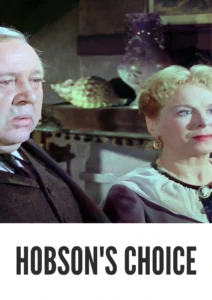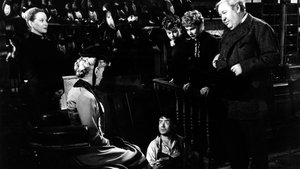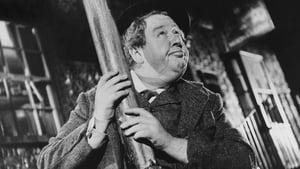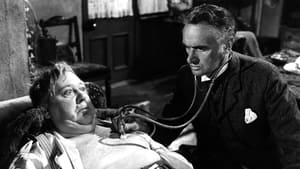Video Sources 0 Views
- Watch trailer
- Hobson's Choice 1954 Colorized


Synopsis
Table of Contents
Toggle
Step into the delightful world of Hobson’s Choice, a heartwarming and humorous British comedy from 1954, now beautifully colorized to enhance its timeless appeal. Starring the legendary Charles Laughton, this film tells a captivating story of family dynamics, social rebellion, and the triumph of wit over tyranny. Perfect for lovers of classic comedies and those seeking a feel-good movie experience, this HD download brings a beloved piece of British cinema to life with vibrant color and stunning clarity.
Hobson’s Choice centers around Henry Hobson (Charles Laughton), a tyrannical bootmaker in 1880s Salford, who believes he knows best for his three daughters. He sees his daughters as unpaid shop assistants and has no intention of letting them marry, especially not his eldest, Maggie (Brenda De Banzie), whom he considers too old and opinionated. However, Maggie, a strong-willed and intelligent woman, has other ideas.
Determined to escape her father’s control, Maggie decides to marry Willie Mossop (John Mills), Hobson’s talented but unassuming bootmaker. Maggie sees Willie’s potential and proposes a business partnership and marriage, much to the shock of her father and sisters. Together, Maggie and Willie set up a rival shop, challenging Hobson’s dominance and sparking a series of comedic and heartwarming events. As their business thrives, Hobson’s empire begins to crumble, leading to a hilarious battle of wills and a sweet romance that blossoms against all odds. Hobson’s Choice is a delightful tale of empowerment, love, and the courage to defy expectations.
The film boasts a stellar cast of actors who perfectly capture the spirit of this classic comedy:
-
Charles Laughton as Henry Horatio Hobson
-
Brenda De Banzie as Maggie Hobson
-
John Mills as William “Willie” Mossop
-
Richard Wattis as Albert Prosser
-
Prunella Scales as Vicky Hobson
Hobson’s Choice falls into the genre of British comedy, with elements of romance and social commentary. Its witty dialogue, endearing characters, and heartwarming story make it a timeless classic that appeals to audiences of all ages.
Released in 1954, Hobson’s Choice reflects the changing social landscape of post-war Britain. The film’s themes of female empowerment and social mobility resonated with audiences who were experiencing a period of significant change and opportunity. Hobson’s Choice is not only a delightful comedy but also a reflection of the era in which it was made, capturing the spirit of a nation striving for progress and equality.
This colorized version of Hobson’s Choice has been meticulously restored using state-of-the-art digital techniques, enhancing the visual experience while retaining the film’s original charm and character. The colorization process involved careful analysis of the original black and white footage, with close attention paid to historical accuracy and aesthetic appeal. The result is a vibrant and engaging viewing experience that breathes new life into this beloved classic, making it accessible and enjoyable for modern audiences.
-
: David Lean
-
: David Lean, Norman Spencer, Wynyard Browne
-
: the play by Harold Brighouse
-
: Jack Hildyard
-
: Peter Taylor
-
: London Films
-
: British Lion Film Corporation
-
: 107 minutes
-
: MP4
-
: HD (1080p)
-
: Compatible with most devices, including smartphones, tablets, computers, and smart TVs.
Hobson’s Choice (1954) is widely regarded as one of the greatest British films ever made, earning critical acclaim for its direction, performances, and screenplay. Charles Laughton’s portrayal of the overbearing Henry Hobson is particularly celebrated, and the film’s themes of social mobility and female empowerment continue to resonate with audiences today. With a score of 100% on Rotten Tomatoes, Hobson’s Choice is a cinematic gem that deserves to be seen and appreciated by generations to come.
-
: What is Hobson’s Choice about?
-
A: Hobson’s Choice is a comedy about a tyrannical bootmaker whose daughters rebel against his control.
-
-
: Is Hobson’s Choice (1954) considered a classic film?
-
A: Yes, Hobson’s Choice is widely regarded as one of the greatest British films ever made.
-
-
: Is this version of Hobson’s Choice colorized?
-
A: Yes, this version has been professionally colorized to enhance the viewing experience.
-
-
: What makes Hobson’s Choice so beloved?
-
A: Hobson’s Choice is a delightful comedy with memorable characters, witty dialogue, and heartwarming themes.
-
-
: What is the download format?
-
A: The download format is MP4, which is compatible with most devices.
-
-
: What resolution is the download?
-
A: The resolution is HD (1080p), providing a high-quality viewing experience.
-
Watch Hobson’s Choice Today!













